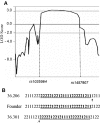Linkage of monogenic infantile hypertrophic pyloric stenosis to chromosome 16p12-p13 and evidence for genetic heterogeneity
- PMID: 16826529
- PMCID: PMC1559485
- DOI: 10.1086/505952
Linkage of monogenic infantile hypertrophic pyloric stenosis to chromosome 16p12-p13 and evidence for genetic heterogeneity
Abstract
Infantile hypertrophic pyloric stenosis (IHPS) is the most common form of bowel obstruction in infancy. The disease affects males four times more often than females and is considered a paradigm for the sex-modified model of multifactorial inheritance. However, pedigrees consistent with autosomal dominant inheritance have also been documented. We analyzed a 3-generation family with IHPS including 10 affected individuals (5 males and 5 females) and mapped the underlying disease locus to chromosome 16p12-p13 (LOD score 3.23) by using a single-nucleotide polymorphism-based genomewide scan. The analysis of 10 additional multiplex pedigrees yielded negative or nonsignificant LOD scores, indicating the presence of locus heterogeneity. Sequence analysis of candidate genes from the chromosome 16 disease interval excluded the presence of pathogenic mutations in the GRIN2A and MYH11 genes.
Figures


Similar articles
-
Infantile hypertrophic pyloric stenosis--genetics and syndromes.Nat Rev Gastroenterol Hepatol. 2012 Nov;9(11):646-60. doi: 10.1038/nrgastro.2012.133. Epub 2012 Jul 10. Nat Rev Gastroenterol Hepatol. 2012. PMID: 22777173 Review.
-
Linkage of monogenic infantile hypertrophic pyloric stenosis to chromosome 16q24.Eur J Hum Genet. 2008 Sep;16(9):1151-4. doi: 10.1038/ejhg.2008.86. Epub 2008 May 14. Eur J Hum Genet. 2008. PMID: 18478043
-
Genome-wide high-density SNP-based linkage analysis of infantile hypertrophic pyloric stenosis identifies loci on chromosomes 11q14-q22 and Xq23.Am J Hum Genet. 2008 Mar;82(3):756-62. doi: 10.1016/j.ajhg.2007.12.023. Epub 2008 Feb 28. Am J Hum Genet. 2008. PMID: 18308288 Free PMC article.
-
Genome-wide linkage analysis in families with infantile hypertrophic pyloric stenosis indicates novel susceptibility loci.J Hum Genet. 2012 Feb;57(2):115-21. doi: 10.1038/jhg.2011.137. Epub 2011 Dec 8. J Hum Genet. 2012. PMID: 22158425
-
Hypertrophic pyloric stenosis in twins: same genes or same environments?Pediatr Surg Int. 2005 Aug;21(8):669-71. doi: 10.1007/s00383-005-1435-4. Epub 2005 Oct 13. Pediatr Surg Int. 2005. PMID: 15965695 Review.
Cited by
-
No association between the SNPs (rs56134796; rs3824934; rs41302375) in the TRPC6 gene promoter and infantile hypertrophic pyloric stenosis in Chinese people.Pediatr Surg Int. 2011 Dec;27(12):1267-70. doi: 10.1007/s00383-011-2961-x. Epub 2011 Aug 6. Pediatr Surg Int. 2011. PMID: 21822655
-
Genetic contribution to motility disorders of the upper gastrointestinal tract.World J Gastrointest Pathophysiol. 2013 Nov 15;4(4):65-73. doi: 10.4291/wjgp.v4.i4.65. World J Gastrointest Pathophysiol. 2013. PMID: 24244875 Free PMC article.
-
New insights into the pathogenesis of infantile pyloric stenosis.Pediatr Surg Int. 2009 Dec;25(12):1043-52. doi: 10.1007/s00383-009-2484-x. Epub 2009 Sep 16. Pediatr Surg Int. 2009. PMID: 19760199 Review.
-
Association between NKX2-5 rs29784 and infantile hypertrophic pyloric stenosis in Chinese Han population.Int J Clin Exp Med. 2015 Feb 15;8(2):2905-10. eCollection 2015. Int J Clin Exp Med. 2015. PMID: 25932253 Free PMC article.
-
Infantile hypertrophic pyloric stenosis--genetics and syndromes.Nat Rev Gastroenterol Hepatol. 2012 Nov;9(11):646-60. doi: 10.1038/nrgastro.2012.133. Epub 2012 Jul 10. Nat Rev Gastroenterol Hepatol. 2012. PMID: 22777173 Review.
References
Web Resources
-
- GeneCards, http://www.genecards.org/index.shtml
-
- Online Mendelian Inheritance in Man (OMIM), http://www.ncbi.nlm.nih.gov/Omim/ (for IHPS, NOS1, MYH11, and GRIN2A)
-
- UniGene, http://www.ncbi.nlm.nih.gov/UniGene/
Publication types
MeSH terms
LinkOut - more resources
Full Text Sources
Other Literature Sources
Miscellaneous

